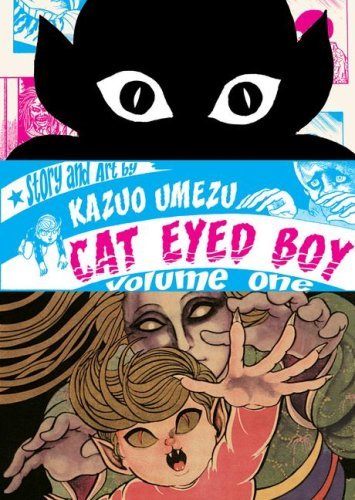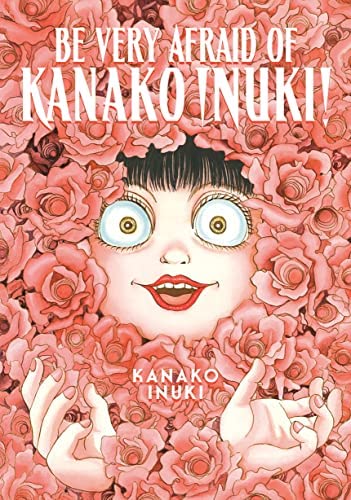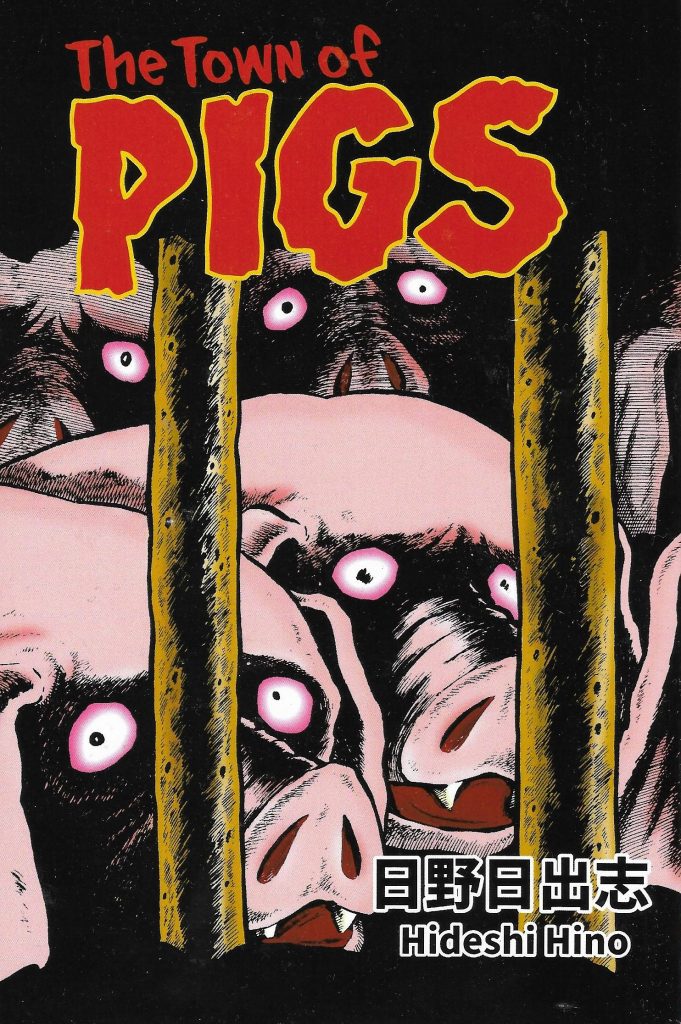Listen… you know what’s scarier than Halloween? Midterms. I had a lot of them. So now I’m dashing off this spooktacular Halloween column a week into November! I’m watching horror movies during Noirvember! I’m getting electrolysis on my upper lip during Movember! I’m eating cashews during No Nut November! Chaos, dogs and cats, you get it. Anyway, what was I gonna do, write a Thanksgiving special? I hate cranberry sauce.
The past year has been a good time for horror comics and a great time if your favorite kind of horror comics are horror manga. I suppose the spectacular success of Viz Media’s Junji Ito reprints, largely culled from a “Greatest Hits” series of Japanese tankobon, has made a pretty deep impact on the market. I reviewed some of those back in the day, I think Jocylene Allen et al. have done a great job on localization and it’s lovely to see the mostly viral word of mouth for Ito’s comics lend itself to a successful line of translations bringing his work to new audiences. I am a little less enthused to see the continuing publication of glorified back catalog scraps clad in tacky hardcover stock, garish computer lettering and graphic design, and little-to-no contextual information receiving a seemingly endless conveyor belt of Eisner awards, effectively scrubbing the Best U.S. Edition of International Material—Asia category out of existence. Fitting indeed that Ito has publicly declared that he has more or less run out of ideas multiple times over at this point, and his work since the fairly memorable Fragments of Horror has been of such drastically diminishing returns that he has lately focused his efforts on special edition trading cards and NFTs, laughable collector’s items that weakly recall his glory days of actually surprising audiences.

As harsh as my criticisms may be, there is certainly little doubt that these increasingly tacky books are bankrolling Viz’s recent forays back into the works of Kazuo Umezz. I’ve reviewed the Drifting Classroom twice for The Comics Journal and more recently had an essay there about Orochi, I need not restate my opinions beyond my undying adoration for the master’s work. Umezz is one of those rare horror artists who really understands that great horror is not about fear but amid fear, the exploration of heightened narratives akin to the racing thoughts we have when afraid or upset. An Umezz comic might not always be scary to all readers, but it will always be vivid, vivid the way that the anxieties and fantasies that consume a distressed child’s mind are vivid. Umezz gets you, you dig me? I certainly hope the forthcoming Cat-Eyed Boy reprint is only a sign of more to come.
Kodansha has recently thrown their hat in the ring with a possible competing horror artist showcase, hitching their star to horror manga fan favorite Kanako Inuki with the anthology Be Very Afraid of Kanako Inuki! Inuki is a huge deal in the Japanese scene, her illustrations are a near-constant presence on the covers of horror manga magazines in the 90s. This is not the first time she’s appeared in English either, with Dark Horse making a few attempts in the ‘00s that sadly landed with a thud. Like Viz’s Ito line, Be Very Afraid is a greatest hits collection, with short stories and chapters cherry-picked across Inuki’s body of work. Each story is accompanied by some reflections by Inuki and – can you believe it? – a note of where and when each story was first published! OMG!? Following each story, Inuki shares cute stories and top five lists – it’s a very personable introduction to the artist, parasocial as the kids say. This is a book that by design works overtime to get you familiar with Kanako Inuki, friendly even, a little cozy. I can’t remember the last time I read a horror anthology this chatty. I liked that a lot!

So, how about Inuki’s comics? Like Umezz, Inuki is very keen on exploiting the fears and secret passions of children, along with something of a grotesque parody/pastiche of horror manga. Inuki likes telling stories about wide-eyed whiny girly-girl brats whose distended buglike faces swell with tears and snot and they demand to be given all the treats and toys and attention they want right now or else. The girls in Inuki’s manga take the greatest lengths possible in their attempts to fulfill their narcissistic juvenile demands, leaving puddles of gore and wreckage in their wake, sometimes self-inflicted. Aging and beauty are recurrent themes, with more than one cute little girl reduced to a withered husk as a consequence of their nagging fixation to become more than they already are as fast as possible. The leering presence of boys and grown-ups sometimes protrudes out of the shadows, but is never quite acknowledged, with the arguable exception of the story “Bukita-kun Lolita” which initially seems to be about a pedophile’s fixation on a child before veering off in an unexpected direction. These horror-comedy vignettes exploit the heightened hysteria of feminized children’s media iconography to comment on the ridiculous and vile shit women can get up to all by themselves under the wicked oppressive thumb of patriarchy. Basically, I’m saying these are good comics.
On the small press side, like really small small press, a new challenger has emerged in the form of Star Fruit Books, who recently announced an all-horror imprint Blood Orange. This line retroactively includes last year’s much-delayed (I only got my copy a few months ago) Town of Pigs, the triumphant return of the horror manga god Hideshi Hino, who is best known stateside for comics masterpieces such as Panorama of Hell, The Red Snake, and Hell Baby, and definitely not for a direct-to-video gore FX showcase that a TV has-been thought was real one time. Hino comics are abrasive and terminal, full of maggots and screaming and inevitable awful deaths. Town of Pigs is a swift descent into grand guignol, a nightmare that begins with a shadowy group abducting a child’s parents and escalates into a nightmare scenario that blends factory farming, human experimentation, and genocide in a billowing mess of burning meat and swollen limbs. The despair and urgency of the work is something special – the violent ceremony witnessed over these pages impresses on us time and time again that the boy whose frightened eyes we peer out at the massacre from can never go home, may never escape, his humanity will be revoked painfully and he will never know why. It’s all a very postwar nightmare. Good shit if you are looking for a work of fiction scary enough to replace your usual mundane intrusive thoughts.

It seems that the future bodes well for readers of manga about creeping doom and despair. I certainly hope we’ll have more Umezz, Inuki, Hino, and more in the years to come (and maybe a bit less Ito). Lord knows I would gladly summon a demon for a shot at a nice English language retrospective of Daijiro Morohoshi. But a part of me wonders if we’ll ever find a portrait of the horror manga subgenre that reflects a deeper glance into the Japanese scene than star artists. Having taken a sideways glance at magazines like Monthly Halloween and Monthly Susperia, one will encounter a horror manga demographic that is trendy, fashion-forward yet strangely keen on reportage about the latest squishy gore effects. It’s often repeated that Japanese horror manga magazines are “for girls” but my own glances at some late 80s anthologies seem pitched more towards horror fans than any gendered demographic – the stylings often pastiche shojo manga and fashion magazines, but page after page of features on all the cool icky violence in movies like The Thing and Evil Dead suggest to me an audience of trend-conscious subcultural weirdos no more or less gendered than any other collective subculture of obsessive freaks and geeks. As is often the case when it comes to manga, I think the received wisdom among English language critics on these anthologies is superficial and what we have in translation barely even grazes that superficial knowledge. I would love to know more, and so I end this year’s spooktacular on a note of curiosity and excitement for all that lies ahead, and everything that goes bump in the dark.
And candy. I love candy. I have a huge bowl of leftover Halloween candy here, nobody comes trick-or-treating round these parts anymore, way too much here for me. Leave a comment in the comments section below if you would like some candy!
SOLRAD is made possible by the generous donations of readers like you. Support our Patreon campaign, or make a tax-deductible donation to our publisher, Fieldmouse Press, today.

Leave a Reply